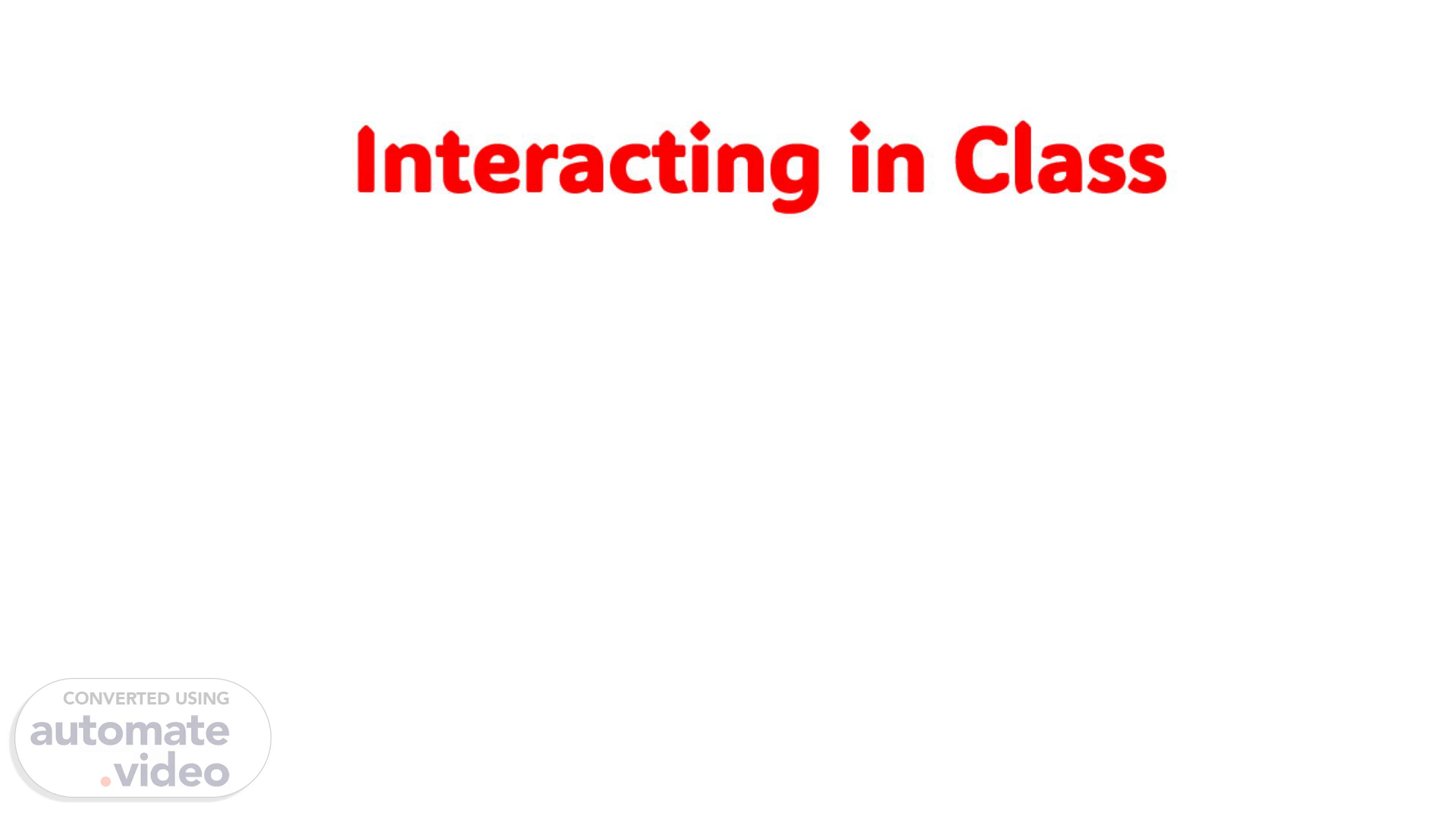Scene 1 (0s)
Interacting in Class. Unit 1.
Scene 2 (6s)
Related image. Listening to a lecture. Image result for group or pair.
Scene 3 (24s)
How to organize small group discussion?. Are there any roles in a group? If yes, what are they? What do these roles do? (responsibilities of each role) Beside their own roles, what does each member have to do in common?.
Scene 4 (41s)
Organizing small group activities. Role 1: Leader Starts the activity Makes sure everyone participates Keeps everyone on the subject Keeps the discussion moving Keeps track of the time.
Scene 5 (54s)
Role 2: Summarizer Explains the situation or problem Makes sure everyone understand the situation Role 3: Reader Reads aloud the instructions, situations, questions Role 4: Reporter Reports the group’s results/ ideas to the class Role 5: Observer (when necessary) Observes the group/ individuals Fills out observation form.
Scene 6 (1m 11s)
Duties of group members. Beside the duties of the main role, each person must: Present ideas Support ideas with examples, details, and reasons Ask the others for their ideas.
Scene 7 (1m 25s)
Organizing Small Group Activities. LEADER. READER.
Scene 8 (1m 41s)
Step 1: (after the teacher divides the class into small groups) Whole group: Take the roles: leader, summarizer, reader & reporter Step 2: Reader: reads the situation Step 3: Summarizer: analyzes the situation Step 4: Leader: Starts the debate Step 5: (whole group) discuss in 8-10 minutes Step 6: Reporter: Summarizes the group’s ideas Step 7: Leader: chooses the best solution.
Scene 9 (2m 5s)
Situation Sample: An old, homeless man spends every day in the public library. For most of the day, he sits quietly reading newspaper’s, magazines, and books. Many people in the library have complained that the man is extremely dirty and smells terrible. Also, they say that he sometimes stares at them in a strange way that makes them nervous. The homeless man, however, says that he does nothing to bother anybody. Discuss: What are possible ways that library officials might deal with this situation?.
Scene 10 (2m 29s)
Post activity Discuss the following: Did each group member take his or her role during the discussion? If not, why not? Did all group members take ac active part in reaching in the fial decision? If not, why not? How can you improve your next discussion?.
Scene 11 (2m 47s)
Image result for brainstorming. Brainstorming. Write the topic Say anything on the topic List all the ideas without comment Write down ideas quickly Get everyone involved Try to build or add ideas Quantity > quality.
Scene 12 (3m 4s)
Chain brainstorming. Take turn giving an idea. Say “Pass” if you cannot offer an idea.
Scene 13 (3m 16s)
1. Work in a small group. 1. Spend ten minutes brainstorming excuses that David can give his teacher. (e.g) "A robber broke into my house last night and stole it." "My dog ate it for breakfast." Use your imagination and have fun thinking of ideas. Try to produce a list of at least twenty excuses..
Scene 14 (3m 48s)
2. Spend 5 minutes chain brainstorming possible ideas. - The reporter should write every idea as it is mentioned. 3. At the end of 5 minutes, review your ideas. - Cross out any ideas that do not seem to fit. - Spend one or two more minutes adding any new ideas that come to mind..
Scene 15 (4m 23s)
Relationship?. Professional role?. Using appropriate language styles.
Scene 16 (4m 38s)
Neutral/Polite • Would you mind explaining your last point, please? • Could you please explain that again? Informal/direct • Excuse me? • Can you explain that? • Please explain that. Highly Informal • What are you talking about? • What? • Hull?.
Scene 17 (4m 51s)
A. B. C. D. E. F. G. H. I. J. Asking your boss for a raise Discussing a homework assignment with a classmate Asking a friend to go out for a cup of coffee Being interviewed for a job Asking the teacher about a homework assignment Asking the teacher to raise your grade on an important writing assignment Having a meeting at work with several co-workers Presenting a paper at a scientific conference Talking with an important government leader at an official reception Complaining to a co-worker about a serious mistake he made.
Scene 18 (5m 13s)
Participating in class. Find out what your teacher prefers to be called Take initiative in class by volunteering to answer questions Respond immediately if the teacher calls on you to answer a question.
Scene 19 (5m 25s)
Speaking out in class (p.23). Draw attention of the teacher Raise your hand. Call the teacher by name. Leaning forward and making eye contact with the teacher. lf the teacher doesn't notice these signals, you can also say: - Excuse me,. . . . - May I ask a question? - Could I make a comment? 2. Holding the floor: Hesitating Repeating or rephrasing the question Asking the instructor to repeat questions if you don’t understand 3. Avoid answering:.
Scene 20 (5m 47s)
Signaling You Want to Speak - Excuse me,. . . . -May I ask a question? - Could I make a comment? Holding the Floor When the teacher calls on you, you can give yourself a moment or two to think before answering by: Hesitating - Well, umm. - Umm, let's see. - Umm, let me see. - Let me think ..
Scene 21 (6m 5s)
Repeating or rephrasing the question - In other words, you want to know. - So, you're asking me .... Asking the instructor to repeat the question if you don’t understand - Would you mind repeating the question, please? - Would you please repeat that? Avoiding Answering - I'm not really sure. - I don't really know. - I'm afraid I don't know. - I'm sorry, but I don't know..
Scene 22 (6m 24s)
Cross-Cultural Communication.
